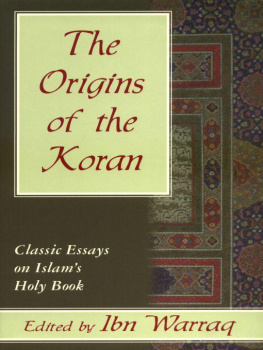Ibn Warraq - Koranic Allusions: The Biblical, Qumranian, and Pre-Islamic Background to the Koran
Here you can read online Ibn Warraq - Koranic Allusions: The Biblical, Qumranian, and Pre-Islamic Background to the Koran full text of the book (entire story) in english for free. Download pdf and epub, get meaning, cover and reviews about this ebook. year: 2013, publisher: Prometheus Books, genre: Religion. Description of the work, (preface) as well as reviews are available. Best literature library LitArk.com created for fans of good reading and offers a wide selection of genres:
Romance novel
Science fiction
Adventure
Detective
Science
History
Home and family
Prose
Art
Politics
Computer
Non-fiction
Religion
Business
Children
Humor
Choose a favorite category and find really read worthwhile books. Enjoy immersion in the world of imagination, feel the emotions of the characters or learn something new for yourself, make an fascinating discovery.
- Book:Koranic Allusions: The Biblical, Qumranian, and Pre-Islamic Background to the Koran
- Author:
- Publisher:Prometheus Books
- Genre:
- Year:2013
- Rating:5 / 5
- Favourites:Add to favourites
- Your mark:
Koranic Allusions: The Biblical, Qumranian, and Pre-Islamic Background to the Koran: summary, description and annotation
We offer to read an annotation, description, summary or preface (depends on what the author of the book "Koranic Allusions: The Biblical, Qumranian, and Pre-Islamic Background to the Koran" wrote himself). If you haven't found the necessary information about the book — write in the comments, we will try to find it.
Scholars have long known that the text of the Koran shows evidence of many influences from religious sources outside Islam. For example, stories in the Koran about Abraham, Moses, Jesus, and other characters from the Bible obviously come from the Jewish Torah and the Christian Gospels. But there is also evidence of borrowing in the Koran from more obscure literature.
In this anthology, the acclaimed critic of Islam Ibn Warraq has assembled scholarly articles that delve into these unusual, little-known sources. The contributors examine the connections between pre-Islamic poetry and the text of the Koran; and they explore similarities between various Muslim doctrines and ideas found in the writings of the Ebionites, a Jewish Christian sect that existed from the second to the fourth centuries. Also considered is the influence of Coptic Christian literature on the writing of the traditional biography of Muhammad.
Ibn Warraq: author's other books
Who wrote Koranic Allusions: The Biblical, Qumranian, and Pre-Islamic Background to the Koran? Find out the surname, the name of the author of the book and a list of all author's works by series.















 , b, t, th, j,
, b, t, th, j,  , kh, d, dh, r, z, s, sh,
, kh, d, dh, r, z, s, sh,  ,
,  ,
,  ,
,  ,
,  , gh, f, q, k, l, m, n, h, w, y. Short vowels: a, u, i. Long vowels: , ,
, gh, f, q, k, l, m, n, h, w, y. Short vowels: a, u, i. Long vowels: , , , ,
, ,  , d,
, d,  , r, z, s, ,
, r, z, s, ,  for q, for example, in EI2 [the second edition of The Encyclopedia of Islam].)
for q, for example, in EI2 [the second edition of The Encyclopedia of Islam].) = ph as in phial.
= ph as in phial.
 alt, has been transliterated in many different ways. Aloys Sprenger, writing in the nineteenth century, originally transliterated the poet's name as Omayya b. Aby-l-alt, which I changed to Umayya B. Ab al-
alt, has been transliterated in many different ways. Aloys Sprenger, writing in the nineteenth century, originally transliterated the poet's name as Omayya b. Aby-l-alt, which I changed to Umayya B. Ab al-
